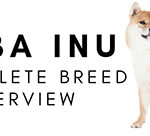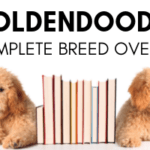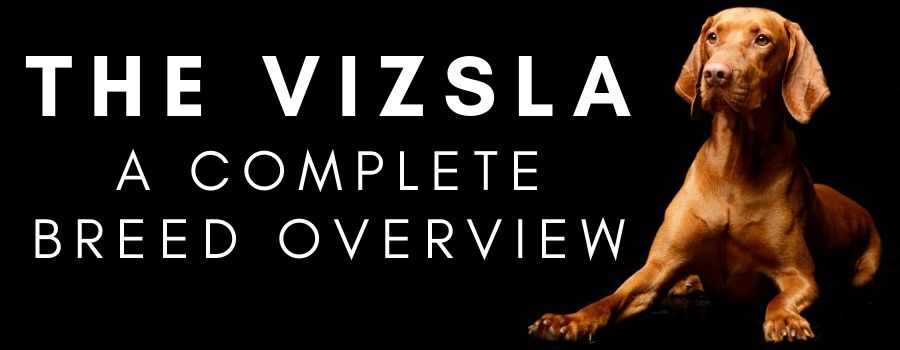
The Vizsla is a beautiful, lean, red-coated companion. Bred initially in Hungary and rapidly trending in the US, they are built for long days outdoors as a hunters companion. This makes them perfect company for a jog or bike ride as they love lots of exercise and spending time outdoors. At home, a Vizsla is a loyal and loving partner. Happy to spend time cuddling up with you and resting their head on your lap.
Vizsla Breed Highlights:
- The Vizsla can trace it’s origins back a thousand years to Magyar Falconers and hunters!
- A Vizsla was the first to win the AKC triple championship!
- Guess what breed was the first Quintuple AKC champion? Yep.
- Friendly, Sweet, Energetic and a great family dog.
- They do shed but their short coats and lack of undercoat make it very manageable.
- They thrive outdoors and require a lot of exercise, beyond just a walk around the block, and make the perfect companion for hikes and running or biking.
In this overview, our goal is to give you a good sense of the Vizsla without overwhelming you. We will cover their fascinating origins dating back a thousand years ago, how they were introduced to the US following their near demise, their success in AKC competitions, and finally important breed specifics, including Appearance, Temperament, Grooming, Health and much more.
Table of Contents
Origin Story of the Vizsla
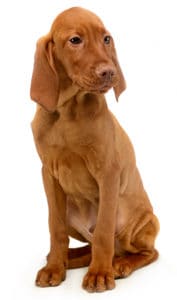
While the exact origin is a bit obscured, the Vizsla was bred by Hungarian nobility and even further back in 8th century Europe. The Magyar people were the predecessors to modern Hungary and were known for their hunting dogs that could keep up with their cavalry. It is thought that these dogs lead to the Vizsla we see in Hungarian bloodlines. So from the very beginning, these dogs were bred to have a lot of stamina.
Vizsla is a word that means pointer in Hungarian. They were used as hunting companions for most of their history. A Vizsla was recognized as a trusted and loyal favorite from a thousand years ago till today. The Hungarian owners made sure they were the fast, adaptable and wonderful all-around dog we see here.
Vizsla Comes to America
In the US, the Vizsla began arriving after the close of World War II. At that time the Russians occupied Hungary. Locals feared the Vizslas would be killed since they were a symbol of wealth and affluence. It was around this time that they were taken to other countries including America. The Vizsla Club of America shows the first dogs arriving here in 1950. They were smuggled here with the help of a US State Department official. A pair of pups in Kansas City, and since that time they’ve been exploding in popularity! AKC currently has them as the 31st most popular breed of dog in America! Ahead of more commonly seen dogs like the Maltese, Chihuahua or Border Collie.
AKC Performance:
Vizslas are synonymous with versatility. They have so many of the traits and qualities you’d want in a companion. They are intelligent, friendly, loyal, athletic, light-footed and have a sweet disposition. This is reflected in their AKC performance.
The first AKC Triple Champion, Kai, was a Vizsla that won the titles in 1980 for show, field and obedience. Pretty impressive!
In 2000, a Vizsla named Chartay, became the First Quintuple Champion in AKC history. Incredibly winning in 5 different disciplines and entering the AKC Hall of Fame. I mean, this dog has his picture up in a hall of fame for dogs! AKC named him the most accomplished in their history (source).
So yes, this is a breed of distinction. If you’re like me when I first found out about them, you wondered why you had not heard more about the Vizsla earlier.
Physical Appearance of the Vizsla
Take Away: They look great! This is a sleek red-coated, lean, active dog with a lovable face and floppy ears. Mid-sized and similar in appearance to a Weimaraner.
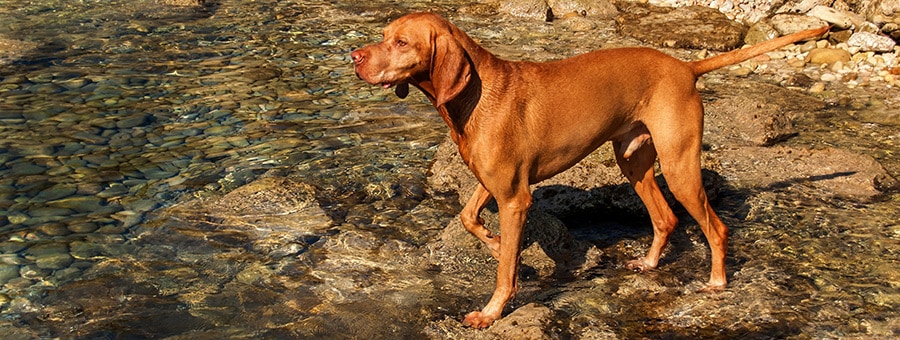
The Vizsla is a medium-sized dog at around 50 pounds, with a short coat. Their coloring is an iconic red typically known as Golden Rust. The coat can vary a bit in shade from a more Red to a Sandy Yellow but it is largely uniform. This reddish-brown coloring gives them some camouflage when in a forest hunting environment. Their coat is dense with no undercoat.
Light, lean, muscular and athletic in appearance, they look the part of a pointer, retriever and hunting dog. They have longer floppy ears, a solid more square muzzle, and a sweet face.
Their athletic appearance means they need a ton of activity to stay healthy. This is what makes them such a good activity partner for running or hiking. As a puppy, they do need exercise also, but you need to bear in mind that they are still developing muscles and joints. You can read our recommendations on how long and hard you can play with them in this guide. Not too much, watch for signs they need more or less running around.
Temperament of the Vizsla
Take Away: The Vizsla is a sweet, sensitive and loving dog. Friendly around his family and even strangers if well socialized. They are a very high energy breed so be aware they will enthusiastically jump as puppies.
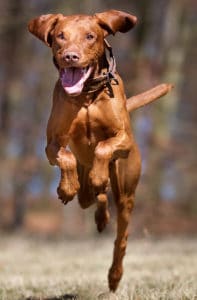
Vizslas are also commonly labeled in the “Velcro” dog category due to their love of being close to their humans. This is an important part of their nature, as owners need to commit to socializing and giving their Vizsla the attention they need for a happy life.
Easier than most to train, highly intelligent and wanting to please. Fearless dogs with a protective instinct, you will not find a Vizsla to be shy or nervous. They are also not aggressive, making them a great fit as a family dog, and less so a guard dog.
These dogs are known for their loving and friendly nature, which makes them a fantastic family dog (more on that here). Considered “soft” dogs they will respond best to positive training rather than a harsher method. You want to be sure that they are well socialized and have a lot of time with the family and other people. These are not kennel dogs or a ‘leave them alone’ type of breed!
Can Vizslas be left alone?
The short answer is yes, they can be left alone. Understand though that they are not going to like it much. If you’re leaving a Vizsla alone for extended periods she’s going to be lonely and potentially act out. Having other dogs around helps tremendously and having someone check-in is the best option.
Vizslas are bred to be companion hunters and highly value their time with their humans. They want to be with you and near you. Make sure you take this into account when considering this breed. Along with daily exercise, this is the most important consideration: How much time can you devote to your dog.
Mental and Physical Exercise Needs of the Vizsla
Physical Exercise is essential for a happy and healthy dog. Vizslas more than most, need some daily outlet to their energy. They want to be outdoors running with you, following on your bike, out hiking, swimming, hunting, or any other physical activity you enjoy.
As a puppy, we recommend as a rule of thumb that you give your Vizsla 5 minutes of exercise for each month of age, twice a day. So at 3 months, you’d have two 15 minute exercise sessions. Now, this may not seem like much, and you might end up doing more, but understand that as puppies they are still developing. You don’t want to overdo it, and especially not on hard surfaces that might be rough on their still-forming joints.
Adult Vizslas are bred to go all day long. So we are looking at a minimum of 45-60 minutes of serious exercise each day. A quick walk around the block is not going to be enough for a high energy dog like the Vizsla. This is why they make the ideal companion for an active person. Going for a morning run with your beautiful red-coated companion is a wonderful start to the day! In this article, we talk about the exercise needs of Vizslas in much more detail
Mental Stimulation is another crucial component of dog ownership. Vizslas crave your attention and love to spend time with you. Here we are mostly talking about any engagement with your dog. Things like playing fetch or tug are a good basic start. More advanced scent games or agility training are a bit more complex examples you can work up to.
Basic obedience training is a great start to your new puppies relationship. Teaching fundamentals like sit and stay, learning their name, getting them engaged with chew toys… all great ways to keep your dog stimulated and let them feel loved.
Here’s a quick rundown of some things you can start with. Each of these is its own article but for now, we will just give the basics so you can start your plans:
- Chew Toy Training: This is the intentional training to get your dog into chewing toys to relieve energy. Huge help for so many situations. There is a reason we put this one first!
- Name Training: What’s your name? Something every new puppy needs to know.
- Sit – Stay – Down: The big 3 for a new puppy. Teaching these with some treats and progressing to them understanding and complying without treats.
- Walking on Leash: Taking your dog out for a walk and teaching them the boundaries and how to stay with you without a struggle.
- Potty Training: Another staple of puppy-hood. How to go outside to relieve themselves. As with most training, consistent repetition is key. Go out to the same spot each time at regular intervals.
Grooming Needs of the Vizsla
Take Away: Vizslas have a short coat and they do shed. No undercoat means less seasonal shedding. They require only occasional grooming and nail trimming. Bathe as needed.
Vizslas are low maintenance with their coats. They do self-clean and have almost no “dog odor”. An occasional bath, a bit of brushing and some nail trimming and they are well set.
Shedding
Vizslas shedding is around average for a dog. Regular brushing will help keep things manageable. You can read more about the extent of their shedding and their self-cleaning habit in this article of ours.
Bathing
They are a self-grooming dog, meaning they will lick themselves and self-clean. They are also low odor so bathing need not be overly frequent. Once every month or two might do the job depending on circumstances.
Nail Trimming
You’ll need to trim their nails regularly. Under most circumstances, they won’t wear naturally. Once every few weeks if you keep up with it, once a month at a minimum.
Health Issues with the Vizsla
Take Away: Vizslas are a healthy breed. They have an excellent screening process in place for responsible breeders. You’ll be able to see what concerns might be in their parents and make informed decisions.
A largely healthy purebred dog, but like any breed, they do have some concerns. Epilepsy, eye problems, blood clotting disorders, and hip dysplasia are among the common health issues to ask your vet and breeder about.
A good breeder will screen for these issues and be able to present parent information. The Canine Health Information Center (CHIC), is a dog health database that you can use to check the health of puppies parents. You can find the recommended list of tests here.
And you can search their database for your prospective puppies mom and dad, who should have a CHIC number when registered. Note that a CHIC number does not mean all tests are normal, just that they are tested and the results are available. Good breeders will screen for health issues and minimize risk.
As with all dogs, a healthy diet goes a long way. For Vizslas a lot of physical exercise is needed to ensure health. Plenty of mental stimulation and socialization are also required.
Food and Supplemental Needs of the Vizsla
In general, you are looking for foods that are free from processed ingredients and grains like corn or soy. High protein and ideally geared for the age of your dog, from puppy, adolescent, adult and senior. We will have a full food guide for you here at Trending Breeds, but for now, try and avoid dog food with these in the ingredients:
- Corn, Wheat or Soy (especially as a first ingredient)
- Meat-by-products or any heavily processed meats
- Meat meals or mash
- Ethoxyquin
- Propylene Glycol
- Food colors, dyes etc
- Artificial flavoring
- BHA’s
- Cellulose
- Rendered Fats
You’ll also want to get advice from your Vet on any special needs your Vizsla might have. Take into account what your breeder has been feeding them as well. Speaking of breeders….
Tip for Working with a Vizsla Breeder
If you are in the process of looking for a Vizsa of your very own, the search typically leads to a Vizsla breeder. You’ll want to be sure and find a reputable person who raises happy and healthy animals! Fortunately, there are a lot of ways to tell if you’re on the right track.
Breeders Should:
- Show that all health tests are done and they can produce an OFA Certificate from the Orthopedic Foundation of Animals (OFA). OFA will provide numbers to check in their searchable database.
- Show that health tests for Vizslas performed by the Canine Health Center and able to provide CHIC certificates.
- Give a good response when you ask them if they try to breed Vizslas that adhere to the AKC breed standard.
- Screen you and ask what the environment you’ll provide is like. Things like how much time will the dog be alone, do you have a fenced-in yard, can you give them exercise, love and attention? This is a good sign they care about their charges. They want to find the best home for their dogs, and a good fit is more important than anything else.
Breeders Should Not:
- Ask to meet you someplace other than his place of business.
- Claim he does not have the parents on site. This is a potential red flag and you should find out all the details of why if this is the case.
- Show you parents that display undesirable traits, such as extreme shyness or aggression.
Where to Start
We would recommend you start with the AKC listings in their puppy marketplace, here.
Being listed on AKC is NOT a guarantee of anything. Use the above guidelines to check and see if the breeder knows what they are talking about. Health testing, safe and clean environment you can visit, parents are there, the breeder is asking you if you can provide a good home — all of these are signs of a good honest breeder.
These Breeds Are Similar to the Vizsla
- Wirehaired Vizslas are a separate breed but closely related to the Vizsla. The main difference as the name implies is the wirehair coat and scraggly appearance. Check him out here.
- Weimaraners are a bit bigger and have that distinctive silver/gray coat. My grandparents had a Weimaraner named Lulu 🙂 You can read about them here.
- German Shorthaired Pointers are another sleek pointer breed that looks similar to the Vizsla.
You’ll find answers to your other Vizsla questions and maybe some you haven’t thought of, HERE.



